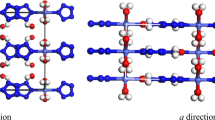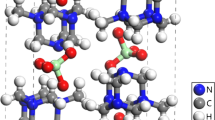Abstract
The density functional theory (DFT) was applied to investigate the structure, optical properties, and non-bonded interactions of the cyclo-pentazolate salt [Mg(H2O)6(N5)2]·4H2O in the pressure range of 0–100 GPa. The results show that there is a structural transition at the pressure of 64 GPa, which has not been found in the experiments. As the pressure increases, the band gap gradually decreases with a sudden increase at the structural transition point. The analysis of DOS presents that the electronic localization in the crystal gradually weakens under the pressure. The structural transition point also exists in the hydrogen bonds and the Hirshfeld surfaces under compression. The absorption spectra of the cyclo-pentazolate salt at high pressures show some strong bands in the fundamental absorption region. The increasing pressure helps to improve the photoelectric performances of the crystal. Our studies are expected to provide a new understanding of the structural transition of the novel energetic materials under high pressures.











Similar content being viewed by others

References
Craddock J (2006) Advanced propulsion for low earth orbit and beyond. International Space Development Conference, Los Angeles CA
Fried LE, Manaa MR, Pagoria PF, Simpson RL (2001) Design and synthesis of energetic MATERIALS1. Annu Rev Mater Res 31:291–321
Gao H, Shreeve JM (2011) Azole-based energetic salts. Chem Rev 111:7377–7436
Göbel M, Karaghiosoff K, Klapötke TM (2010) The first structural characterization of a binary P-N molecule: the highly energetic compound P3N21. Angew Chem Int Ed 45:6036–6040
Dippold AA, Klapötke TM (2013) A study of Dinitro-bis-1,2,4-triazole-1,1′-diol and derivatives: design of high-performance insensitive energetic materials by the introduction of N-oxides. J Am Chem Soc 135:9931–9938
Kettner MA, Klapotke TM (2014) 5,5’-Bis-(trinitromethyl)-3,3′-bi-(1,2,4-oxadiazole): a stable ternary CNO-compound with high density. Chem Commun 50:2268–2270
Butler RN, Stephens JC, Hanniffy JM (2004) First reversible protonation of the all-nitrogen 1-aryl pentazole ring. Tetrahedron Lett 45:1977–1979
Carlqvist P, Ostmark H, Brinck T (2004) The stability of arylpentazoles. J Phys Chem A 108:7463–7467
Wu Q, Pan Y, Xia XL, Shao YL, Zhu WH, Xiao HM (2013) Theoretic design of 1,2,3,4-tetrazine-1,3-dioxide-based high-energy density compounds with oxygen balance close to zero. Struct Chem 24:1579–1590
Qiu L, Zhu WH, Xiao JJ, Xiao HM, Huang H, Li JS (2007) Ab initio and molecular dynamics studies of crystalline TNAD (trans −1,4,5,8-Tetranitro-1,4,5,8-tetraazadecalin). J Phys Chem B 110:10651–10661
Joo YH, Shreeve JM (2010) High-density energetic mono- or bis(oxy)-5 nitroiminotetrazoles. Angew Chem Int Ed 49:7320–7323
Xu XJ, Zhu WH, Xiao HM (2007) DFT studies on the four polymorphs of crystalline CL-20 and the influences of hydrostatic pressure on ε-CL-20 crystal. J Phys Chem B 111:2090–2097
Wu Q, Pan Y, Zhu WH, Xiao HM (2013) Computational study of energetic nitrogen-rich derivatives of 1,4-bis(1-azo-2,4-dinitrobenzene)-iminotetrazole. J Mol Model 19:1853–1864
Ugi I, Huisgen R, Clusius K (1956) Zur Reaktion des Benzol-diazonium-Ions mit Azid Nachweis des Phenyl-pentazols als Zwischenstufe. Angew Chem 68:753–754
Benin V, Kaszynski P, Radziszewski JG (2002) Arylpentazoles revisited: experimental and theoretical studies of 4-hydroxyphenylpentazole and 4-oxophenylpentazole anion. J Org Chem 67:1354–1358
Butler RN, Hanniffy JM, Stephens JC, Burke LA (2008) A ceric ammonium nitrate N-dearylation of N-p-anisylazoles applied to pyrazole, triazole, tetrazole, and pentazole rings: release of parent azoles. Generation of unstable pentazole, HN5/N5-, in solution. J Org Chem 73:1354–1364
Bi FQ, Xu C, Fan XZ, Ge ZX, Xu M (2012) Synthesis and decomposition kinetics of p-tert-Butylphenylpentazole. Chin J Expl Propell 35:56–60
Zhao JF, Li QS (2004) Akinetic stability study of MN5+(M=Be, Mg, Ca, Sr and Ba). Int J Quantum Chem 98:485–494
Zhang XL, Yang JQ, Lu M, Gong XD (2014) Theoretical studies on the stability of phenylpentazole and its substituted derivatives of -OH, -OCH3, -OC2H5 and -N(CH3)2. RSC Adv 4:56095–56101
Xu Y, Wang Q, Shen C (2017) A series of energetic metal pentazolate hydrates. Nature 549:78–81
Zhang QH, Zhang WQ, Wang KC (2018) Stabilization of the pentazolate anion in a zeolitic architecture with Na20N60 and Na24N60 nanocages. Angew Chem 57:2592–2595
Lu M (2017) Thinking on the density and energy level of all nitrogen anion N5− metal salt. Chin J Energ Mater 25:530–532
Segall MD, Lindan PJD, Probert MJ, Pickard CJ, Hasnip PJ, Clark SJ, Payne MC (2002) First-principles simulation: ideas, illustrations and the CASTEP code. J Phys Condens Matter 14:2717–2744
(2014) Material Studio 7.0. Acceryls Inc., San Diego CA
Hamann DR, Safran SA (1979) Long-range elastic interactions and staging in graphite intercalation compounds. Phys Rev Lett 42:1410–1413
Kresse G, Furthmüller J (1996) Efficient iterative schemes for ab initio total-energy calculations using a plane-wave basis set. Phys Rev B 54:11169–11186
Fletcher R (1987) Practical methods of optimization. Wiley, New York
Perdew JP, Chevary J, Vosko S, Jackson KA, Pederson MR, Singh D, Fiolhais C (1992) Atoms, molecules, solids, and surfaces: applications of the generalized gradient approximation for exchange and correlation. Phys Rev B 46:6671–6687
Byrd EFC, Rice BM (2007) Ab initio study of compressed 1,3,5,7-tetranitro- 1,3,5,7-tetraazacyclooctane (HMX), cyclotrimethylenetrinitramine (RDX), 2,4,6,8,10,12- hexanitrohexaazaisowurzitane (CL-20), 2,4,6-trinitro-1,3,5-benzenetriamine (TATB), and pentaerythritol tetranitrate (PETN). J Phys Chem C 111:2787–2796
Younk EH, Kunz AB (1997) An ab initio investigation of the electronic structure of lithium azide (LiN3), sodium azide (NaN3), and lead azide [Pb(N3)2]. Int J Quantum Chem 63:615–621
Wolff S, Grimwood D, McKinnon J, Turner M, Jayatilaka D, Spackman M (2012) Crystal explorer. The University of Western Australia, Perth Australia
Saha S, Sinha TP, Mookerjee A (2000) Electronic structure, chemical bonding, and optical properties of paraelectric BaTiO3. Phys Rev B: Condens Matter Mater Phys 62:8828–8835
Author information
Authors and Affiliations
Corresponding author
Ethics declarations
Conflict of interest
The authors declare that they have no conflict of interest.
Additional information
Publisher’s note
Springer Nature remains neutral with regard to jurisdictional claims in published maps and institutional affiliations.
Rights and permissions
About this article
Cite this article
Li, Y., Li, B. & Xie, L. Structural transformation of energetic cyclo-pentazolate salt under the pressure. Struct Chem 31, 1887–1896 (2020). https://doi.org/10.1007/s11224-020-01544-6
Received:
Accepted:
Published:
Issue Date:
DOI: https://doi.org/10.1007/s11224-020-01544-6



